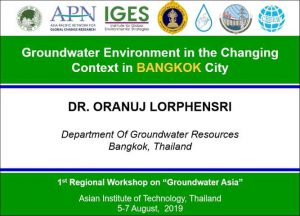Publications
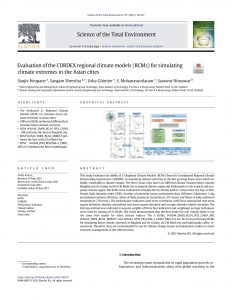
Evaluation of the CORDEX regional climate models (RCMs) for simulating climate extremes in the Asian cities
This study evaluates the ability of 21 Regional Climate Models (RCMs) from the Coordinated Regional Climate Downscaling Experiment (CORDEX) in simulating climate extremes in the fast growing Asian cities which are highly vulnerable to climate change. The three Asian cities have two different climate characteristics, namely Bangkok and its vicinity and Ho Chi Minh City in tropical climate region and Kathmandu in sub-tropical and tem-perate climate region. The RCMs were evaluated to simulate the six climate indices; Consecutive Dry Days (CDD), Simple Daily Intensity Index (SDII), Number of extremely heavy precipitation days (R50mm), Maximum 1-day precipitation amount (RX1day), Mean of daily maximum temperature (TX mean) and Mean of daily minimum temperature (TN mean). The performance indicators used were correlation coefficient, normalized root mean square deviation, absolute normalized root mean square deviation and average absolute relative deviation. The Entropy method was endorsed to acquire weights of these four indicators and weightage average techniques were used for ranking of 21 RCMs. The result demonstrated that the best model for one climate index is not the same best model for other climate indices. The 3 RCMs; WAS44_SMHI_RCA4_IPSL_CM5A_MR, WAS44_SMHI_RCA4_MIROC5, and WAS44_IITM_REGCM4-4_CSIRO_MK3-6-0 are the best performing RCMs for simulating future climate extremes in Bangkok and
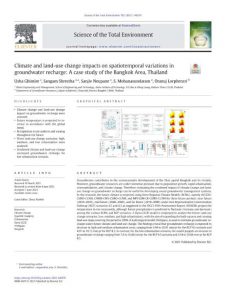
Climate and land-use change impacts on spatiotemporal variations in groundwater recharge: A case study of the Bangkok Area, Thailand
Groundwater contributes to the socioeconomic development of the Thai capital Bangkok and its vicinity. However, groundwater resources are under immense pressure due to population growth, rapid urbanisation, overexploitation, and climate change. Therefore, evaluating the combined impact of climate change and land-use change on groundwater recharge can be useful for developing sound groundwater management systems. In this research, the future climate is projected using three Regional Climate Models (RCMs), namely ACCESS-CSIRO-CCAM, CNRM-CM5-CSIRO-CCAM, and MPI-ESM-LR-CSIRO-CCAM for three future periods: near future (2010–2039), mid future (2040–2069), and far future (2070–2099) under two Representative Concentration Pathway (RCP) scenarios 4.5 and 8.5 as suggested in the IPCC’s Fifth Assessment Report. All RCMs project the temperature to rise incessantly, although future precipitation is predicted to fluctuate (increase and decrease) among the various RCMs and RCP scenarios. A Dyna-CLUE model is employed to analyse the future land-use change scenarios (low, medium, and high urbanisation), with the aim of expanding the built-up area and creating land-use maps covering the period to 2099. A hydrological model, WetSpass, is used to estimate groundwater recharge under future climate and land-use change. The findings reveal that groundwater recharge is expected to decrease in high and medium urbanisation areas, ranging from 5.84 to
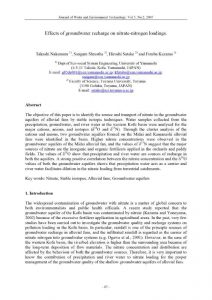
Effects of groundwater recharge on nitrate-nitrogen loadings
The objective of this paper is to identify the source and transport of nitrate in the groundwater aquifers of alluvial fans by stable isotopic techniques. Water samples collected from the precipitation, groundwater, and river water at the western Kofu basin were analyzed for the major cations, anions, and isotopes (δ18O and δ15N). Through the cluster analysis of the cations and anions, two groundwater aquifers formed on the Midai and Kamanashi alluvial fans were identified in the basin. Higher nitrate concentrations were observed in the groundwater aquifers of the Midai alluvial fan, and the values of δ15N suggest that the major sources of nitrate are the inorganic and organic fertilizers applied in the orchards and paddy fields. The values of δ18O show that precipitation and river water are sources of recharge in both the aquifers. A strong positive correlation between the nitrate concentration and the δ18O values of both the groundwater aquifers shows that precipitation water acts as a carrier and river water facilitates dilution in the nitrate loading from terrestrial catchments.
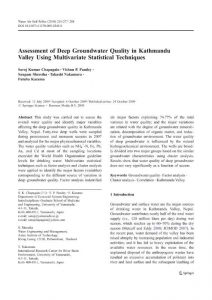
Assessment of Deep Groundwater Quality in Kathmandu Valley Using Multivariate Statistical Techniques
Ho Chi Minh City (HCMC), Vietnam has undergone tremendous transformation in land-use practices in the past few decades. The groundwater-related issues have also been a major concern in the fast-growing southern city of Vietnam. Quantitative prediction of the impact on groundwater recharge due to changes in the land-use pattern of a watershed is crucial in developing sound groundwater management schemes. This study aims to evaluate the impacts of change in land-use patterns on the quantity of groundwater recharge in HCMC. An empirical land-use projection model (Conversion of Land-use and its Effects, Dyna-CLUE) and a hydrological model (Soil and Water Assessment Tool, SWAT) was used for the study. Three future land-use scenarios of Low Urbanization Scenario (LU), Medium Urbanization Scenario (MU) and High Urbanization Scenario (HU) were developed in Dyna-CLUE focusing on the increase of built-up area to generate land use maps of HCMC until the year 2100. The land-use maps for all three scenarios were then used in the calibrated hydrological model SWAT to get the future recharge in the near future (2016–2045), mid future (2046–2075) and far future (2076–2100). The recharge was observed to increase in the far future of LU by 10% while reduction of 30% and 52%
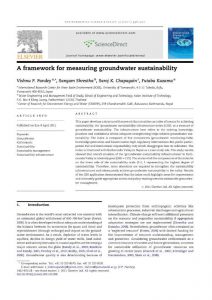
A framework for measuring groundwater sustainability
Ho Chi Minh City (HCMC), Vietnam has undergone tremendous transformation in land-use practices in the past few decades. The groundwater-related issues have also been a major concern in the fast-growing southern city of Vietnam. Quantitative prediction of the impact on groundwater recharge due to changes in the land-use pattern of a watershed is crucial in developing sound groundwater management schemes. This study aims to evaluate the impacts of change in land-use patterns on the quantity of groundwater recharge in HCMC. An empirical land-use projection model (Conversion of Land-use and its Effects, Dyna-CLUE) and a hydrological model (Soil and Water Assessment Tool, SWAT) was used for the study. Three future land-use scenarios of Low Urbanization Scenario (LU), Medium Urbanization Scenario (MU) and High Urbanization Scenario (HU) were developed in Dyna-CLUE focusing on the increase of built-up area to generate land use maps of HCMC until the year 2100. The land-use maps for all three scenarios were then used in the calibrated hydrological model SWAT to get the future recharge in the near future (2016–2045), mid future (2046–2075) and far future (2076–2100). The recharge was observed to increase in the far future of LU by 10% while reduction of 30% and 52%
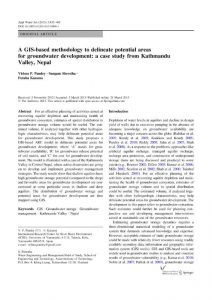
A GIS-based methodology to delineate potential areas for groundwater development: a case study from Kathmandu Valley, Nepal
Ho Chi Minh City (HCMC), Vietnam has undergone tremendous transformation in land-use practices in the past few decades. The groundwater-related issues have also been a major concern in the fast-growing southern city of Vietnam. Quantitative prediction of the impact on groundwater recharge due to changes in the land-use pattern of a watershed is crucial in developing sound groundwater management schemes. This study aims to evaluate the impacts of change in land-use patterns on the quantity of groundwater recharge in HCMC. An empirical land-use projection model (Conversion of Land-use and its Effects, Dyna-CLUE) and a hydrological model (Soil and Water Assessment Tool, SWAT) was used for the study. Three future land-use scenarios of Low Urbanization Scenario (LU), Medium Urbanization Scenario (MU) and High Urbanization Scenario (HU) were developed in Dyna-CLUE focusing on the increase of built-up area to generate land use maps of HCMC until the year 2100. The land-use maps for all three scenarios were then used in the calibrated hydrological model SWAT to get the future recharge in the near future (2016–2045), mid future (2046–2075) and far future (2076–2100). The recharge was observed to increase in the far future of LU by 10% while reduction of 30% and 52%
Thesis
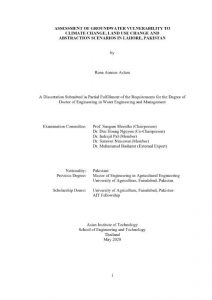
Assessment of Groundwater Vulnerability to Climate Change, Land Use Change and Abstraction Scenarios in Lahore, Pakistan
Urban aquifers are facing increasing pressure from climate change, land use change and abstraction, altering groundwater levels and threatening sustainable water consumption availability and utilisation. Therefore, this study projects future changes of climate, land use and abstraction, while analysing the vulnerability of groundwater levels to such changes and formulating adaptation options to reduce the vulnerability of groundwater resources in Lahore. The objectives are achieved using modelling and qualitative approaches. The results show an increase in mean and extreme climate under climate change scenarios. The warm and wet extremes are projected to increase (significant at P=5%) under medium (RCP4.5) and high end (RCP8.5) scenarios. Annual changes in all climate indices will be significant except for the warm spell duration index. Land use projections show increased built-up in land use type from 965 to 3716 km2 and 3329 km2 under R1S1 and R2S2 scenarios (significant at P=5%). The built-up land use will dominate agriculture land use in the future. The future population will increase (significant at P=5%) from 6.4 M to 24.6, 27.5 and 28.7 M under SSP1, SSP2 and SSP3 scenarios, respectively. The vulnerability of urban areas will increase in the future due to the high negative impact and low adaptive
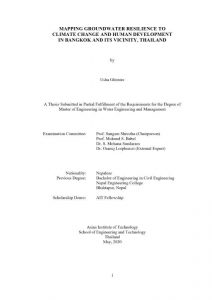
Mapping Groundwater Resilience to Climate Change and Human Development In Bangkok And Its Vicinity, Thailand
Ho Chi Minh City (HCMC), Vietnam has undergone tremendous transformation in land-use practices in the past few decades. The groundwater-related issues have also been a major concern in the fast-growing southern city of Vietnam. Quantitative prediction of the impact on groundwater recharge due to changes in the land-use pattern of a watershed is crucial in developing sound groundwater management schemes. This study aims to evaluate the impacts of change in land-use patterns on the quantity of groundwater recharge in HCMC. An empirical land-use projection model (Conversion of Land-use and its Effects, Dyna-CLUE) and a hydrological model (Soil and Water Assessment Tool, SWAT) was used for the study. Three future land-use scenarios of Low Urbanization Scenario (LU), Medium Urbanization Scenario (MU) and High Urbanization Scenario (HU) were developed in Dyna-CLUE focusing on the increase of built-up area to generate land use maps of HCMC until the year 2100. The land-use maps for all three scenarios were then used in the calibrated hydrological model SWAT to get the future recharge in the near future (2016–2045), mid future (2046–2075) and far future (2076–2100). The recharge was observed to increase in the far future of LU by 10% while reduction of 30% and 52%
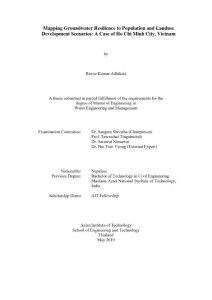
Mapping Groundwater Resilience to Population and Landuse Development Scenarios: A Case of Ho Chi Minh City, Vietnam
Ho Chi Minh City (HCMC), Vietnam has undergone tremendous transformation in land-use practices in the past few decades. The groundwater-related issues have also been a major concern in the fast-growing southern city of Vietnam. Quantitative prediction of the impact on groundwater recharge due to changes in the land-use pattern of a watershed is crucial in developing sound groundwater management schemes. This study aims to evaluate the impacts of change in land-use patterns on the quantity of groundwater recharge in HCMC. An empirical land-use projection model (Conversion of Land-use and its Effects, Dyna-CLUE) and a hydrological model (Soil and Water Assessment Tool, SWAT) was used for the study. Three future land-use scenarios of Low Urbanization Scenario (LU), Medium Urbanization Scenario (MU) and High Urbanization Scenario (HU) were developed in Dyna-CLUE focusing on the increase of built-up area to generate land use maps of HCMC until the year 2100. The land-use maps for all three scenarios were then used in the calibrated hydrological model SWAT to get the future recharge in the near future (2016–2045), mid future (2046–2075) and far future (2076–2100). The recharge was observed to increase in the far future of LU by 10% while reduction of 30% and 52%
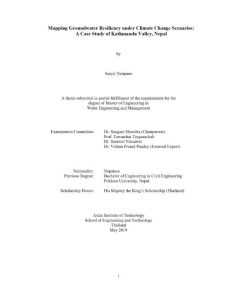
Mapping Groundwater Resiliency under Climate Change Scenarios: A Case Study of Kathmandu Valley, Nepal
Ho Chi Minh City (HCMC), Vietnam has undergone tremendous transformation in land-use practices in the past few decades. The groundwater-related issues have also been a major concern in the fast-growing southern city of Vietnam. Quantitative prediction of the impact on groundwater recharge due to changes in the land-use pattern of a watershed is crucial in developing sound groundwater management schemes. This study aims to evaluate the impacts of change in land-use patterns on the quantity of groundwater recharge in HCMC. An empirical land-use projection model (Conversion of Land-use and its Effects, Dyna-CLUE) and a hydrological model (Soil and Water Assessment Tool, SWAT) was used for the study. Three future land-use scenarios of Low Urbanization Scenario (LU), Medium Urbanization Scenario (MU) and High Urbanization Scenario (HU) were developed in Dyna-CLUE focusing on the increase of built-up area to generate land use maps of HCMC until the year 2100. The land-use maps for all three scenarios were then used in the calibrated hydrological model SWAT to get the future recharge in the near future (2016–2045), mid future (2046–2075) and far future (2076–2100). The recharge was observed to increase in the far future of LU by 10% while reduction of 30% and 52%
Presentations
Methodology for Groundwater Resiliency Indicators and Mapping
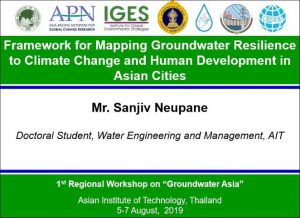
Framework for Mapping Groundwater Resilience to Climate Change and Human Development in Asian Cities
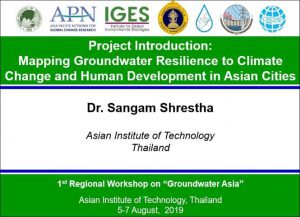
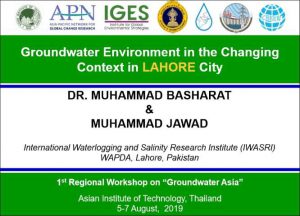
Groundwater Environment in the Changing Context in Lahore City
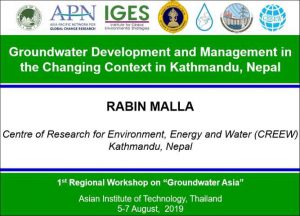
Groundwater Development and Management in the Changing Context in Kathmandu, Nepal
